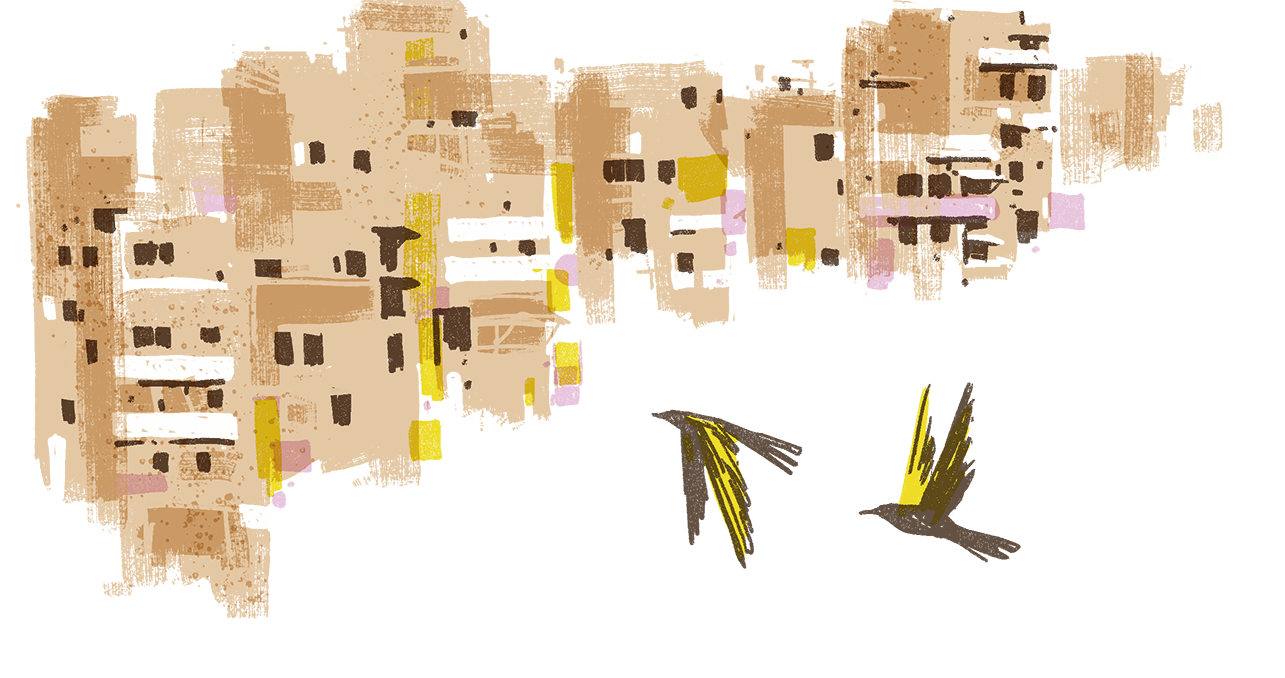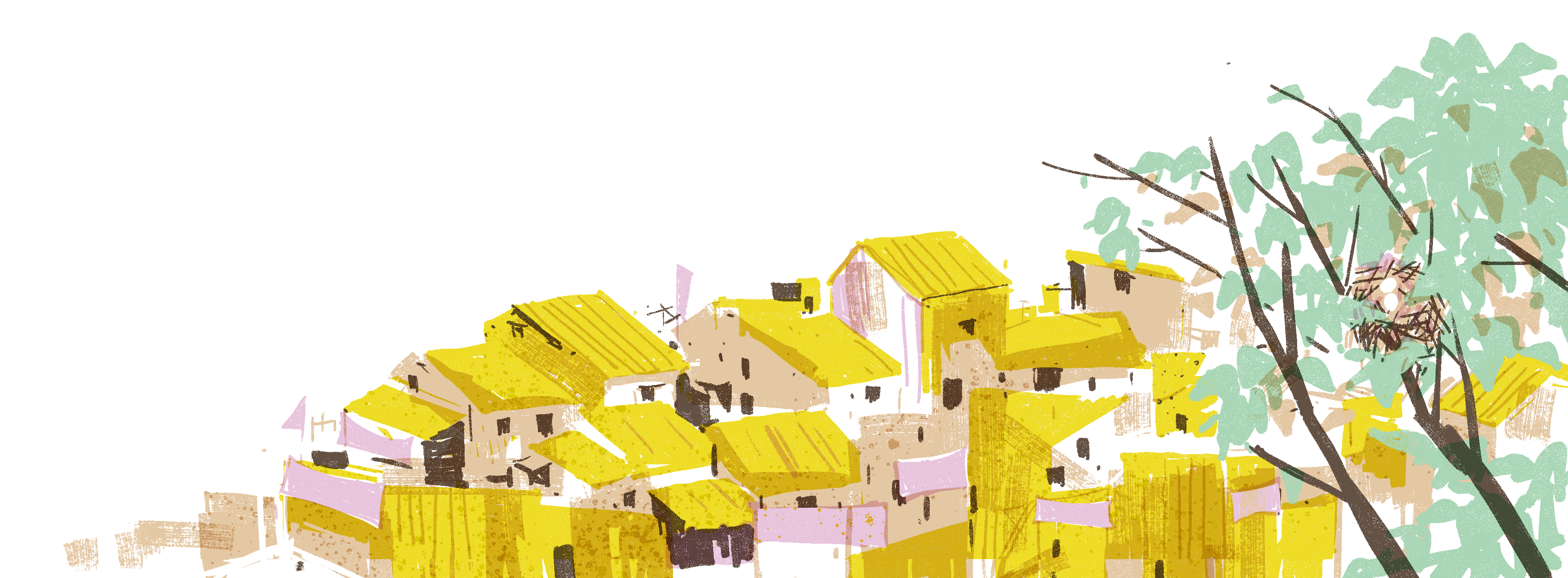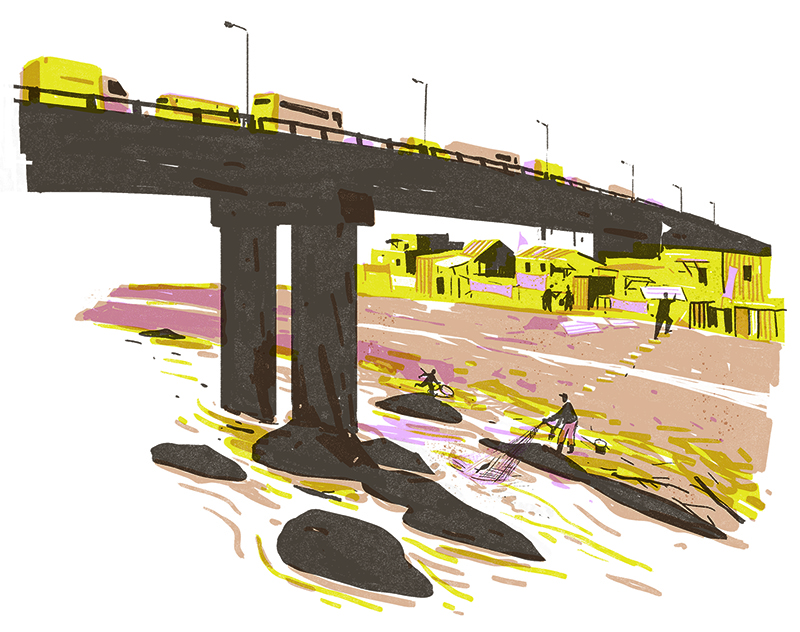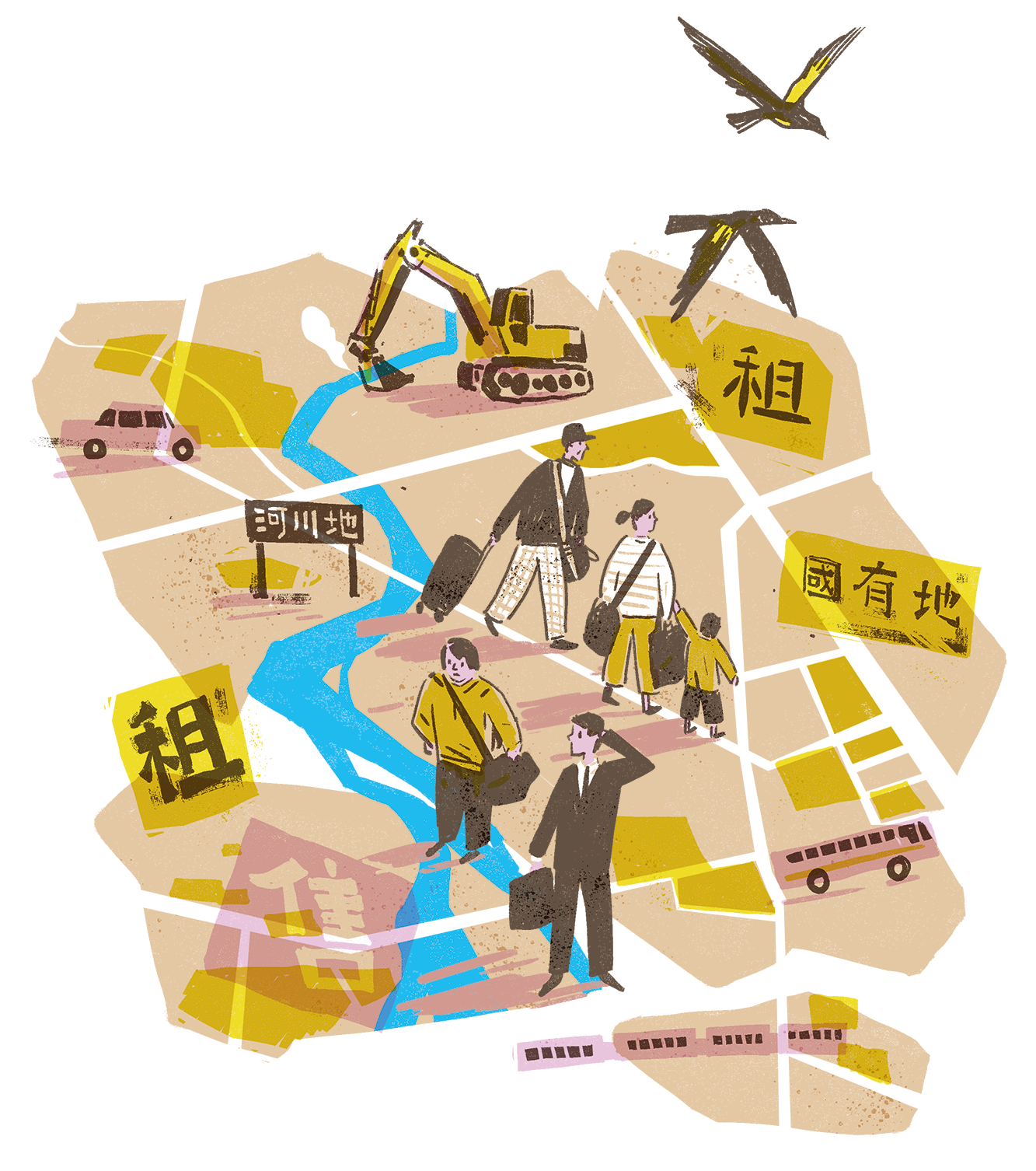
So I say farewell to my home beside the mountain
I do not want to weep
I thought I was good enough I would not be afraid
I took care and raised myself
These are the lyrics from Panai Kusui's “The Wanderer”, a song that expresses the loneliness and frustration of an indigenous teenager who moved to the city alone to make a living. According to the Council of Indigenous Peoples’ 2018 statistics, the percentage of indigenous peoples who have registered their household in urban areas have reached 46.9%. The total number of indigenous peoples actually living in urban areas may have already exceed 50%.
Around the 1960s, industrialization and capitalism greatly impacted traditional economic structures and caused a large amount of people to move to the cities. During this social transformation, the traditional livelihoods of indigenous peoples, such as traditional farming, hunting, or fishing could no longer support their households. The high demand for laborers in cities also attracted people from the indigenous villages to the urban areas.
In the early days, urban indigenous peoples mainly took on low social class, high-risk jobs in construction, mining, and offshore fishing, occupations that were described as “the highest, the deepest, and the farthest jobs”. Even now, most of them still work in labor-intensive jobs to make a living. Although cities offer more employment opportunities than their home villages, living in the city is more costly, making it difficult for urban indigenous peoples to truly improve their economic situations. As a result, it is nearly impossible for community members to buy or even rent a house in the city.

This is My Home:
Indigenous Communities on the Edges of the Cities
Though life in the city is tough, indigenous laborers still did their best to make the most out of their situations. They sought out and connected with one another. They built and settled down in new homes on the edges of urban areas, forming new settlements with a community identity. Carrying on the collective nature of the people, indigenous community members started to invite their family and friends from home to work and live in the city together. Most of the urban indigenous communities are Pangcah communities, including a couple of communities near Dahan River and Xindian River in New Taipei City, the Kuaileshan Community in Ruifang, Keelung; and the Sa’owac Community in Taoyuan. The Ljavek Community in the center area of Qianzhen District, Kaohsiung City is mainly inhabited by Paiwan people due to its location. And following the lifestyles of indigenous peoples, these communities are often located next to rivers.
Urban indigenous communities are not only physical shelters from the elements, but also an important place for community members to connect with each other and pass on culture and traditions. In the past few decades, these close-knit urban indigenous communities have developed their own community identities, cultures, and ceremonial rites. For example, the first generation of residents in Xizhou Community (New Taipei City) originally came from various home villages in eastern Hualien, including Matai’an, Guangyin, Tafalong, Zhangyuan. Shoufeng, and Kalotongan; but they slowly formed a common identity in their new “urban home village”. Carrying over their original Pangcah culture and traditions, they now have their own community leader and social structure and organization, and hold annual rites and ceremonies.
The Ljavek Community in Qianzhen District, Kaohsiung City, is another unique example. During the 1950s, Ljavek Community was situated amid many factories next to the canal. Quality of life here was very poor. Nevertheless, since the Paiwan people are used to migrating and a lot of community members worked in the wood industries in the neighboring Fusing area, city-dwelling Paiwan people gradually gathered here and eventually formed a new community. They named this new home “Ljavek”, meaning “by the waters”. Following the social customs of the Paiwan community, the members elected an elder from the home village chief's family as the Chief of Ljavek Community, and hold harvest rites according to the calendar back home. Although the community is located in the urban area, everyone in this community can speak the Paiwan language.
In 1958, Formosa Plastics Group built petrochemical factories in the area. The “founding factories” of the Group was built right next to the community, squishing the originally-expansive community into a narrow space between the factory fences and canal. Community members who have lived through that period recall when the factories emitted flue gas, plastic dust with chemical odors would fall from the sky like snow.
Later the factories closed down and the canal was filled up. But the elevated road caused the community to flood whenever there was heavy rain. The military dependents’ villages on the other side of the canal was torn down and rebuilt into public housing, new shopping centers such as Costco, Ikea, and Dream Mall slowly appeared in nearby areas. Qianzhen District was quickly transforming, while the Ljavek Community seemed to be forgotten by time, quietly watching the development and changes of the city with its wooden walls and tin roofs.
After over six decades of living here, these urban indigenous communities are no longer temporary dwellings for the community members. They have seen three, even four generations of grandchildren grow and live there. For the residents, this is home.

Denied by the National Mechanism:
Endless Violent Displacement and Dispersion
Back then although there wasn’t much to go around, the urban indigenous peoples at least had a stable home. Unfortunately, this type of lifestyle was no longer possible after the 1990s. “Occupiers”, “squatters” were what local governments called these urban indigenous community members who took part in early city development and contributed their labor and strength. “We helped build this city, yet now they are going to kick us out” is the collective sigh of urban indigenous community members all over Taiwan.
──Northern Riverbank Communities──
In 2007, former Taipei County (now New Taipei City) launched the “Great Bi-Tan Reform Plan”. During the progress of redesigning and restoring the waterway, a couple of Pangcah urban indigenous communities on the banks of Xindian River were forcibly dismantled and relocated elsewhere by the government. Within two to three years, riverbank communities including Sanying, Xiaobitan, Kanjin, and Sa’owac were involuntarily relocated.
At that time, residents at Xizhou Community petitioned to KMT president candidate Ma Ying-Jeou and expressed their wish to keep their homes. But Ma responded with “I view you as fellow human beings”, “we need to educate you”, “the indigenous people have to adjust their mindset”, which sparked much discussion and dispute about this issue.
Afterwards, the County government proposed the “Sanxia Long-en-pu public housing project” as a response. However, it failed due to overly high rent and unsuitable living spaces. Yet the threat of forced relocation never stopped. Local governments claimed the urban indigenous communities were illegal and directly demolished the houses or sued the residents. These actions reinforced the image of “the residents are illegally occupying public land” and supported the government’s moves to tear down the houses to reclaim the land, or even demanding compensation from the residents.
The northern riverbank communities were strongly supported by the academia, art and culture circle, and social movement groups during the struggle, and consequently attracted a lot of attention; also because the area is located in the political and economic center of Taiwan, media exposure, resources, and human resources could be leveraged effectively. In the end, the situation started to show a glimmer of hope.
Around 2016, the Sanying Community Self-help Association and Xizhou Community Self-help Association reached an agreement with New Taipei City Government: “settle us properly in another area and help us rebuild the community”. A safer location not far from the original site was chosen for the new community. The local government revised the land usage category (it was originally reserved for urban planning use) so that community members can legally rent the land through 20-year contracts. After the contracts expire, residents have priority to rent the land, which is basically equivalent to allowing them permanent residence. As for buildings on top of the land, they follow the “333 Plan”: community members will prepare one-third of the construction budget, the government will subsidize one-third of the amount, and a bank loan will make up the remaining portion. After the buildings are completed, the property rights belong to the shared legal entity of the communities. The layout of the new community is designed according to resident household requirements, and spaces for village ceremonies and activities are planned by the community members themselves.

──Ljavek Community in Kaohsiung City──
However, on the other end of the island, the Ljavek Community in Kaohsiung shared the same fate but not the same outcome. In 1997, Ljavek Community was reported as a squatter community. In an attempt to protect their homes, community members formed a self-help association and petitioned to Kaohsiung City Government. The government proposed the first replacement plan to the Community: residents who are willing to move will go through the social housing system and be relocated to Naluwan Community in Xiaogang District. But this move will indicate an additional NT 3,000 to 4,000 per month in rent and management fees, and families who are allowed to move into social housing are low-income families and can only live there for eight years maximum. As a result, residents have no choice but to move back to the old community location after a couple of years.
Then in 2013, Ljavek Community received another demolition and relocation document from Kaohsiung City Government. Community members petitioned to the city government and city council multiple times. The Kaohsiung City Government Indigenous Peoples Commission also brought the members to New Taipei City to observe the northern riverside communities’ solution. But Kaohsiung City Government arbitrarily decided on the replacement measures without giving community members a chance to hold equal discussions with the government. Using the same social housing relocation plan they used years ago, the government forcefully dismantled old communities and just gave promises that they will do their best to apply for rent subsidies and rent period extensions while asking the community members to “make do for the meantime”.
In this relocation plan, Ljavek community members were arranged to move to Naluwan Community in Xiaogang District and the old Taiwan Power Company dormitories in Wujia District. But the process is flawed as it completely ignores the community’s existing way of life, culture, and its collective societal structure. The dispersion of community members destroyed the former community support system, tearing apart the horizontal connections within the community and forcibly reshaping them into vertical apartment building spaces. Community members lost their original spaces for ceremonies and daily interactions. Moreover, the new living arrangements were very unorganized: the same address may include six households/individuals, and one housing unit at the Wujia Taiwan Power Company dormitory has less than 66 m2 of space, making it impossible to accommodate large families. The “one old house for one new house” swap was a complete failure.
Some community members eventually got tired of dealing with the city government and agreed to be replaced. However, there were still about ten households that refused to budge. In the early morning of April 1st, 2018, the Kaohsiung City Government’s excavator entered the community and began to dismantle the remaining houses. This action finally aroused social awareness on the issue and the public condemned the government for its brutal action. With the help of Legal Aid Foundation, residents sought legal action for the first time and sued Kaohsiung City Government. Right now the case is still in court, but the damage done to community members who have been forced to disperse and lost their homes and houses cannot be undone.
Where is My Home?
How to Raise Awareness on the Collective Needs of Housing and Culture
Even though there is the successful example of Xizhou and Sanying Community achieving a win-win situation through discussions with the government, there are no examples of what the government should do when faced with the collective needs of urban indigenous communities. Especially in the Ljavek Community case, we can see local governments do not have a comprehensive understanding of “informal settlement” and tend to ignore the historical backgrounds of indigenous communities and the communities’ collectiveness. As the result, the replacement plans proposed by the governments only satisfy the requirement of “having a place to live” and completely ignore other elements such as living quality and the need for passing on indigenous cultures. Some governments even think that as long as they propose a replacement plan, it is not forced eviction. During the replacement information session held by the Kaohsiung Council of Indigenous Peoples, Ljavek community members expressed that community culture should not be erased. Kuchung Kalavangan, the Chairperson of the Council at that time, responded that after the replacement, the Council of Indigenous Peoples will publish the Ljavek history as documentation of the community’s past history.
Actually, when the international society talk about protecting the right to adequate housing, it covers more than basic living requirements. In 2009, the Taiwanese government integrated the two UN Covenants on human rights into domestic law; as a result, the two Covenants should have the same effect as domestic law in terms of human rights legal protection and general comments explanations. According to the International Covenant on Economic, Social and Cultural Rights Article 11 and correlating General Comments No. 4 and No.7, it clearly states for the Right to Adequate Housing:
“In the Committee’s view, the right to housing should not be interpreted in a narrow or restrictive sense which equates it with, for example, the shelter provided by merely having a roof over one’s head or views shelter exclusively as a commodity. Rather it should be seen as the right to live somewhere in security, peace and dignity.”
In early 2017, during the second Two Covenants & National Human Rights Review Meeting held by the Ministry of Justice, international human rights experts provided a number of conclusive feedbacks. Number 44 was especially directed towards the issue of urban indigenous communities:
“when providing the public with adequate housing, indigenous culture and collective needs should also be taken into consideration.”
According to the descriptions of Right to Adequate Housing in the two Covenants, replacement does not justify forced eviction, and can only be considered as the last resort for compensation when housing demolition and relocation is inevitable. Whether the housing demolition and relocation case complies with the obligations mentioned in the two Covenants or not have to be determined according to the overall situation, and should at least satisfy the following conditions: the demolition and relocation act has a valid objective, the action complies with the principle of proportionality, and all involved parties can have sincere and thorough discussions on the issue.
There is still room for discussion and improvement when it comes to city development and the human rights of residents. We need to think about other issues in urban development: besides modern cityscapes with tall buildings and skyscrapers, can all residents live in the city equally and with dignity? Can we let traces of history and city development co-exist, and not just reduce them to a page in history archives? “What will happen next to our homes?” remain the biggest question in the hearts of urban indigenous peoples who are still fighting for and protecting their homes. 

—Reference—
林彥彤、Savungaz Valincinan,《致高雄市政府:不是有安置就不叫迫遷》,蘋果日報即時論壇,2018年。
阮俊達,《漂流或紮根?北部都市阿美族河岸部落的居住議題》,臺北:台灣人權促進會季刊,頁20-23,2012年。




